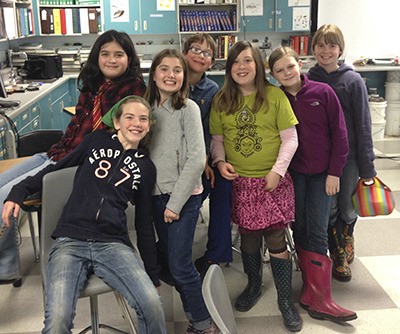by Brigid Ehrmantraut, Taj Howe, and E.A.R.T.H.
Earth Day 2014 is fast approaching, and the Orcas High School Environmental Club is working with the new Elementary E.A.R.T.H. group to plan a great parade!
Here’s what E.A.R.T.H. has to say about itself:
“Hello! We are a group called E.A.R.T.H. What does it stand for? Well, we named our group E.A.R.T.H because we are an “Environmental Association Ready To Help” with any needs involving our world.
The people in our group are Izie (the creator of E.A.R.T.H and the writer), Astasia (The one who named us), Flora (the spokesperson of the group), Sofia (the one who helps decide and the new member), Alanna (the artist), Evie (the other spokesperson), and Lindsey (the organizer).
We are asking the community to participate in a special “Lights Out” project for Earth Day.
Please use minimal electricity from 8:30 a.m. to 2 p.m. on April 22. Help our planet thrive and celebrate Earth day in style. Remember every participant counts. Every person who joins in helps the environment. Thanks so much for your help!”
Are you going to the Earth Day parade? This year’s parade will be on Tuesday, April 22 at 12:30 p.m. and will start outside the Public Elementary School. The theme is “Endangered Animals.”
The following is an excerpt from the website www.earthday.org.
Each year, Earth Day on April 22 marks the anniversary of what many consider the birth of the modern environmental movement in 1970. The height of hippie and flower-child culture in the United States, 1970 brought the death of Jimi Hendrix, the last Beatles album, and Simon & Garfunkel’s “Bridge Over Troubled Water.”
Protest was the order of the day, but saving the planet was not the cause. War raged in Vietnam, and students nationwide increasingly opposed it.
Although mainstream America remained oblivious to environmental concerns, the stage had been set for change by the publication of Rachel Carson’s New York Times bestseller “Silent Spring” in 1962. The book represented a watershed moment for the modern environmental movement, selling more than 500,000 copies in 24 countries.
The idea of “Earth Day” came to founder Gaylord Nelson, then a U.S. Senator from Wisconsin, after witnessing the ravages of the 1969 massive oil spill in Santa Barbara, Calif. Inspired by the student anti-war movement, he realized that if he could infuse that energy with an emerging public consciousness about air and water pollution, it would force environmental protection onto the national political agenda.
Senator Nelson announced the idea for a “national teach-in on the environment” to the national media; persuaded Pete McCloskey, a conservation-minded Republican Congressman, to serve as his co-chair; and recruited Denis Hayes as national coordinator. Hayes built a national staff of 85 to promote events across the land.
As a result, on April 22, a total of 20 million Americans took to the streets, parks, and auditoriums to demonstrate for a healthy, sustainable environment in massive coast-to-coast rallies.
Thousands of colleges and universities organized protests against the deterioration of the environment. Groups that had been fighting against oil spills, polluting factories and power plants, raw sewage, toxic dumps, pesticides, freeways, the loss of wilderness, and the extinction of wildlife suddenly realized they shared common values.



